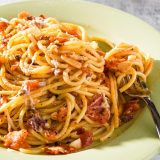Mario Ive’s pasta all’Amatriciana was unlike any Italian red sauce I’d ever tasted. Bright, bold and ... barely there?
I’d come to Rome to learn one of the country’s simplest tomato-based pastas. My teacher was Ive, a retired artillery colonel in the Italian army who decades ago wrote a Roman cookbook in France. Because why not?
As Ive’s house white wine—bought from a fill-your-own-jug counter nearby—flowed freely into our tumblers, he prepared the minimalist equation of pasta, tomatoes, guanciale and pecorino Romano.
The dish is a member of the family of classic Roman pastas, all of which grew out of cacio e pepe. Add guanciale (cured pig jowls) to cacio e pepe and it becomes gricia. Add tomatoes to gricia and you have Amatriciana.
Done in the Italian-American red sauce tradition, Amatriciana is a soupy, wet affair. But as Ive worked in his tiny apartment kitchen in the Roman suburbs—where, clichéd as it sounds, aromas of garlic, tomatoes and roasted meat wafted through the marble courtyard—it was clear this would be something else entirely.
Ive’s recipe was a striking and speedy contrast to the sauces I’m familiar with. A bit of olive oil. A few ounces of guanciale. Four tiny canned tomatoes. No more. And no juices.
Ive cooked it all down until there was barely any moisture in the skillet, just a thick, richly aromatic tomato- pork paste. Into this he stirred the pasta and just enough of its starchy cooking water to loosen the sauce to coat. The pasta finished cooking in the sauce, its flavor permeating the noodles. He finished with pecorino Romano and many generous grinds of black pepper. In about 15 minutes it was on the table.
Despite the sparing use of, well, everything except cheese and pepper, the flavor was intense. It got its punch from cooking down and concentrating small amounts of tomatoes and meat. The result was a sauce with less liquid but more flavor and coating power.
For Milk Street’s version, we stuck with Ive’s minimalism, right down to cook pasta in 4 quarts of well-salted water (“It should taste like seawater,” as Ive put it), for this dish we used half that. We also undercooked the pasta. This upped the flavor in two important ways.
First, it concentrated the starch from the noodles; following Ive’s example, we used that cooking water to thicken and bind the tomatoes. Second, by only partially cooking the pasta in the water, we let it finish cooking in the sauce, thereby absorbing a more flavorful liquid.
Amatriciana is often topped with pecorino Romano cheese, but we wanted it to infuse the entire dish. The solution was to simmer a chunk of the cheese with the pasta as it cooked. Though unconventional, it allowed the cheese to season the pasta throughout, resulting in a more fully flavored finished dish.
We found that one 14½-ounce can of whole tomatoes (even Italians favor canned varieties for their deeper flavor), drained and cooked down, was plenty to dress four servings. Likewise, just 3 ounces of pancetta—more widely available than guanciale—provided ample flavor.




